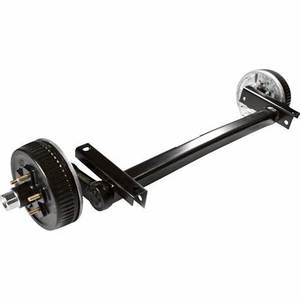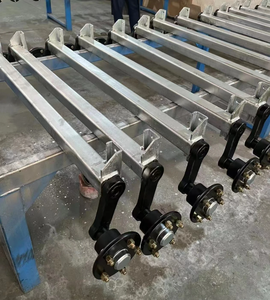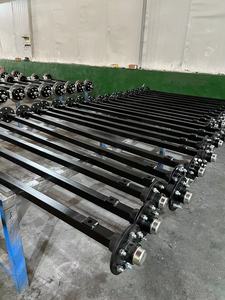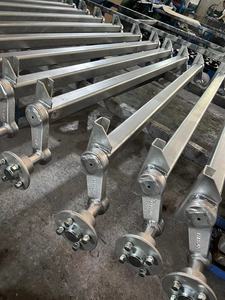
All categories
Featured selections
Trade Assurance
Buyer Central
Help Center
Get the app
Become a supplier

(8118 products available)



















































Single Axle Trailers
As the name suggests, this type of axle has only one axle under the trailer. This setup is more common in lightweight trailers, such as small camping trailers, boat trailers, or motorcycle trailers. The single axle provides better maneuverability, making it easy to turn corners. Additionally, the maintenance costs of single axle trailers are significantly lower. However, these trailers may be more challenging to balance, especially when carrying heavy loads.
Tandem Axle Trailers
Tandem axle trailers have two axles placed close together, providing a total of four wheels. This setup is more common in larger trailers, such as utility trailers, cargo trailers, and larger boat trailers. The tandem axle distributes the weight more evenly and provides better stability, especially when driving at higher speeds. Furthermore, it improves braking performance. The main disadvantage of tandem axle trailers is the increased maintenance costs and reduced maneuverability.
Triple Axle Trailers
Triple axle trailers have three axles under the trailer. This setup is more common in very large trailers, such as those used for long-distance freight transportation or large boat trailers. The triple axle provides the highest load capacity and stability. However, the maintenance costs are significantly higher, and the maneuverability can be a challenge, especially with such a large trailer.
Leaf Spring Light Trailer Axle
These axles use leaf spring suspension systems. The leaf spring suspension system is designed with several layers of spring leaves shaped like a leaf stacked together in a curved position. This design allows the leaf spring light trailer axle to handle heavy loads and provides better stability and durability, making them an ideal choice for utility trailers and livestock trailers.
Torsion Spring Light Trailer Axle
Torsion spring light trailer axles use a torsion spring suspension system. Instead of using traditional coil springs, torsion spring light trailer axles use torsion bars as springs. The bars twist in response to the suspension's up-and-down movement. This design allows for a more compact suspension system, making it suitable for small light trailer axles.
The specifications of light trailer axles are important for two reasons. One, they help buyers understand the features of the axle. Two, they help buyers compare different axles. Here are some common specifications that buyers should pay attention to:
Axle capacity
Axle capacity refers to the maximum weight that an axle can handle. For instance, a 3500 lb light trailer axle can support up to 3500 lbs of weight. The axle capacity is important because it prevents overloading that can cause damage to the axle.
Axle construction
Axles are constructed using different materials. The most common material is steel because of its strength and durability. However, some axles are made from aluminum. Aluminum light trailer axles are lighter and resistant to corrosion.
Number of wheels
Light trailer axles are designed for single wheel or dual wheel setups. Single wheel axles have one wheel on each side of the trailer. On the other hand, dual wheel axles have two wheels on each side. Dual-wheel axles offer better weight distribution and stability.
Wheel bolt pattern
The wheel bolt pattern is important for compatibility with trailer wheels. The pattern is given in terms of the number of bolts and the bolt circle diameter. For example, a trailer axle may have a 5-bolt pattern with a 4.5-inch diameter.
Brake type
Light trailer axles can come with hydraulic brakes or electric brakes. Hydraulic brakes are known for their strength and stopping power. On the other hand, electric brakes provide consistent braking and are suitable for larger trailers.
It is important to maintain light trailer axles for safety and durability. The following tips will ensure that the axle functions properly:
Regular inspections
Trailer owners should inspect their trailers regularly. During the inspection, they should check the condition of the axle for signs of wear or damage. They should also check the axle components like the wheel bearings and brakes. Early detection of problems will allow for timely repairs.
Cleaning
For light trailer axles to function properly, they need to be cleaned regularly. Cleaning prevents dirt and debris from causing damage to the axle components. After each use, especially in muddy or sandy conditions, owners should clean the axle with mild soap and water.
Lubrication
Lubrication is important to reduce friction between moving parts of the axle. Light trailer axle owners should use the manufacturer's recommended lubricant. They should pay special attention to components like wheel bearings and the brake assembly.
Load management
Trailer owners should adhere to the maximum load capacity of the axle. Overloading causes excessive pressure on the axle, which can lead to failure. They should also distribute the load evenly across the length of the trailer. Uneven distribution of load can cause bending or damage to the axle.
Selecting the right lightweight trailer axle is crucial for ensuring that the trailer performs optimally and has a long lifespan. Here are some tips to consider when choosing axles for light trailers:
Load Capacity:
The axle should be selected based on the total weight of the trailer. The axle must have a higher weight rating than the total trailer weight for optimal performance.
Dimensions:
It's important to measure the trailer's wheel and frame clearance before choosing an axle. This is important because it ensures that the axle fits properly into the trailer.
Hitch Type:
The type of hitch connection is also important when choosing a light trailer axle. Some common hitch connections include the ball and pintle connections. Choose an axle with a compatible hitch connection.
Brake System:
Consider the trailer's weight and the intended usage when choosing a braking system for the axle. For heavy trailers and those used in steep terrains, a braking system with higher braking power is required.
Wheel Bearings:
Choose axles with high-quality wheel bearings. This is important because it ensures that the axle lasts for a long time and operates smoothly.
Material:
Axles are usually made from materials such as steel and aluminum. For lightweight trailers, axles made from aluminum are suitable because they are corrosion resistant and lightweight.
It is important for business buyers to understand how to replace trailer axles. Here is a simple guide on how to replace an axle on a trailer:
Safety and Preparation
Ensure safety measures are in place. Get the trailer on a level surface. Get the necessary tools, such as jacks, jack stands, lug wrenches, and socket sets. Disconnect the trailer from the tow vehicle. Make sure the trailer is empty to reduce weight and improve stability. Activate the wheel chocks to prevent the trailer from rolling away. Also, ensure that the electrical connections for the trailer lights are disconnected.
Remove the Wheels
Use a lug wrench to remove the wheel's lug nuts. Then take the wheels off the axle.
Supported the Trailer
Put a jack under the trailer's frame near the axle that is being replaced. Lift the trailer with the jack until the axle is off the ground. After that, put jack stands under the trailer's frame to support it securely. This provides extra stability and safety during the replacement process.
Disconnect the Old Axle
Unscrew the nuts and bolts that attach the axle to the trailer's frame. Then, disconnect any electrical connections for the trailer lights running along the axle. Make sure to follow the wire's routing along the axle and disconnect any zip ties or clamps holding it in place. Take note of the wiring connections, so they can be reconnected in the same way with the new axle. Remove the brake lines attached to the axle using a wrench. Carefully drain any brake fluid in the lines into a suitable container. After that, remove the brake lines from the wheel hubs on the axle using a wrench.
Remove the Old Axle
Slide the old axle out from under the trailer. This may require wiggling or gently prying it loose, depending on how tightly it fits.
Install the New Axle
Slide the new axle into position under the trailer. Make sure it is aligned correctly with the trailer's frame and the wheel hubs. Then, reattach the nuts and bolts to secure the new axle to the frame. Reconnect any electrical connections for the trailer lights, following the notes made during disconnection.
Connect Brake Lines
Use a wrench to attach the brake lines to the new axle's wheel hubs. Bleed the brake lines to remove any air bubbles from the braking system. Dispose of the old axle according to local regulations and environmental guidelines.
Reattach the Wheels
Put the wheels back onto the wheel hubs on the new axle. Use the lug wrench to tighten the lug nuts securely.
Lower the Trailer
Remove the jack stands and lower the trailer gently using the jack. Reconnect the trailer to the towing vehicle and ensure all connections, such as electrical and safety chains, are secure and functioning correctly before driving.
Q1: How often should trailer axle service be done?
A1: It is advisable to have axle services done at least every six months or every 6000 miles. This ensures that the light-duty trailer axle remains in good condition and reduces the risk of axle failure.
Q2: What are the signs of a worn-out trailer axle?
A2: The signs include wheel misalignment, uneven tire wear, vehicle pulling to one side, visible droop or low point in the axle, and leaking grease or oil from the bearings. If these signs are evident, it is necessary to check the axle and replace it if necessary.
Q3: Can a trailer run with a broken axle?
A3: No, a trailer cannot run on a broken axle. A broken axle seriously compromises the trailer's mobility and safety. The trailer can only be towed or transported using a truck or another vehicle until the axle is repaired or replaced.
Q4: What causes trailer axle failure?
A4: Causes include overloading the trailer, lack of regular maintenance, manufacturing defects, and poor road conditions. These causes can lead to axle damage, which can make the trailer unusable.
Q5: How long does it take to replace a trailer axle?
A5: The duration depends on various factors, such as the condition of the old light trailer axle, the complexity of the new axle installation, and the experience of the technician. Replacement can take 2 to 5 hours at most.